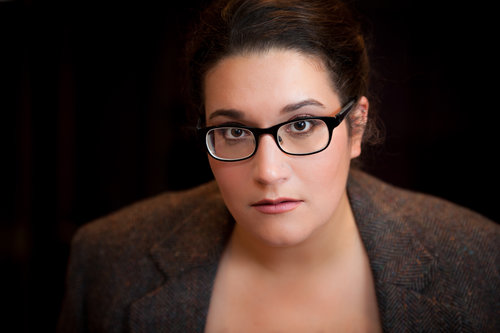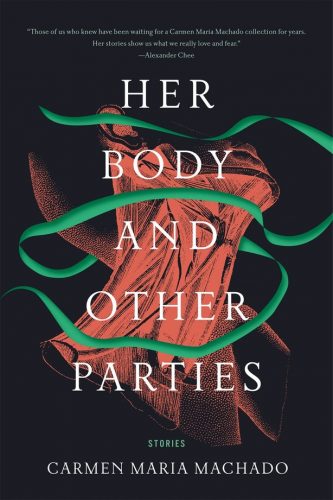Carmen Maria Machado: On the Dark Power of Urban Legends

Author: Alyssa C. Greene
November 13, 2017
With her debut short story collection, Her Body and Other Parties, author Carmen Maria Machado reinterprets and remixes myths, classic horror tropes, and bits of pop culture ephemera to produce a truly unique vision. More than just a series of clever postmodern exercises, the collection is a thoroughly inspired queer reading experience, that offers a darkly inquisitive exploration of women’s lives.
Recently, Machado talked to Lambda Literary about the success of her book, her inspirations, and defying conventional literary devices.
As of this writing, Her Body and Other Parties is now shortlisted for a National Book Award and is already going into its sixth printing. First of all, congratulations! What has this experience been like for you?
Really, really exciting, and really, really unreal. You work on something for so long, and it’s just you and then it’s you and your agent and then you, your agent, and your editor, and then all of a sudden it’s out in the world and people are really into it! It’s the dream, of course, but it’s a completely weird experience.
Your work draws on fables and urban legends, the kind of stories we hear from a very young age. What interests you about these kinds of stories? How do they inform your work?
Fairy tales, urban legends, campfire stories, sleepover games…they all capture something essential about our fears, hopes, and anxieties. They’re as telling as anything about what we value and what we don’t. What better lens to examine our relationship with gender and sex?
The first piece in the collection, “The Husband Stitch,” rewrites “The Green Ribbon” from the woman’s perspective, and calls our attention to the violence and moral undercurrents in a lot of urban legends and folklore, as well as the casual sexism and misogyny embedded in everyday life.
What drew you to “The Green Ribbon,” and how did you go about reimagining it? What were the challenges of working with a legend that so many people are familiar with?
On a very visceral level, I was drawn to this story because I heard it as a kid, it disturbed me, and I’ve never forgotten it. When I went back and actually re-read it, I was struck by the quiet, persistent violence of the story; how Alfred could never leave well enough alone, and lost his wife as a result. It’s sort of the opposite of Bluebeard; in Bluebeard, the burden of the wife’s curiosity is bore by her. In this story, the burden of the husband’s curiosity is still born by the wife.
The challenge is, of course, the fact that I’m fighting against an inevitable ending. I wanted the story to end in the same way as the original, but defamiliarize the narrative enough that it becomes horrifying, even though it hasn’t changed.
In “The Resident,” the protagonist is accused of writing a “madwoman in the attic” story when trying to write a story about mental illness. This story in particular presents the sort of Catch-22 women writers face: wanting to get away from tropes, and then being read through the lens of those tropes anyway. Have you encountered this in your own work?
It’s really hard! I obviously don’t want to lazily invoke tropes about, say, women, but I also hate feeling like I have my hands tied behind my back when I try to tackle anything. When I wrote “The Resident,” I decided to take on this contradiction head-on by writing a richly characterized queer woman who is mentally ill, utterly self-aware and articulate, and actively interrogating these ideas.
The story “Especially Heinous” uses the episode titles from Law & Order: Special Victims Unit as a point of departure for writing a different kind of narrative than fans of the show might be used to. How did this story come about? What made you choose SVU?
The idea from this story came from a few places. For the form, I simply had the idea that I could use episode capsule summaries as a way of building a larger narrative through a sort-of scatterplot structure. As for “Why SVU?” well, it’s our more persistent and relevant contemporary fairy tale and so it was something of a natural fit for this project.
Many of the characters in Her Body and Other Parties are queer, but their queerness is always one among many facets that make up who they are. Could you talk a little bit about writing queer characters?
Sure! I’m not going to sit here and say, “I’m bored with coming-out stories, or queer-trauma stories,” because the truth is that while those stories are not uncommon, we will, I think, always need stories like that. But I wasn’t interested in either of those types of narratives; I was interested in exploring stories where the characters’ queerness was incidental to the decision to tell the story. I think incidental identity markers can be just as powerful as deliberately-invoked ones.
In your acknowledgments, you thank all the women writers who have come before you, and you’ve written elsewhere about both female authors and critics (I’m thinking of this essay on Shirley Jackson and Joanna Russ in particular). Who are some of the authors who have been important to you, and why?
My childhood influences were weirdly disparate: Ray Bradbury, Gloria Naylor, Gabriel García Márquez, Charlotte Brontë, Louis Sachar.
As an adult, the profile narrowed slightly: writers like Kelly Link, George Saunders, Helen Oyeyemi, Alice Sola Kim, Sofia Samatar, Karen Russell, and Angela Carter have been incredibly important to me. All of them break rules and seem to take great, gleeful pleasure from writing—and are excellent at the short story form in particular.
What are you reading right now?
Rebekah Frumkin’s forthcoming novel The Comedown, which I’m loving.
Are you working on any new projects?
Yes! I have an essay collection and a novel-in-stories in progress, and my next published book is my memoir House in Indiana—in which I explore domestic violence in same-sex relationships—which is due to my publisher next fall and is coming out fall 2019.


